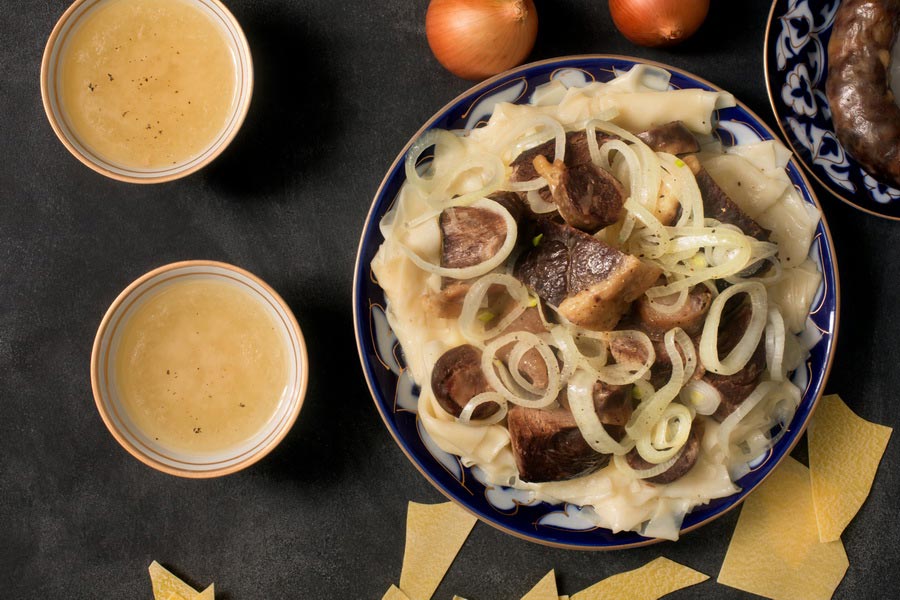
Kyrgyz meat dishes and offal products were the main sustenance of the nomadic Kyrgyz pastoralists for centuries. Although Kyrgyzstan is home to many lakes and reservoirs, Kyrgyz cuisine is surprisingly void of fish, and chicken dishes are also nearly nonexistent. Instead, traditional dishes always involve read meat, liver or other organs from sheep, horses and livestock.
Beshbarmak is a traditional Kyrgyz meat dish which consists of boiled beef or horse meat, broth, onions and doughy homemade noodles. A ram is often specially slaughtered to make beshbarmak, and if there are many guests a cow or a horse may be chosen instead. Sometimes offal is cooked along with the meat. The meat is usually prepared by men and the dough by women. If a man does not know how to chop meat for beshbarmak, they say: "Atasy uirekten emes da" ("His father did not teach him"). It is customary to eat beshbarmak with your hands, and even the name "beshbarmak" means "five fingers". It is believed that the best beshbarmak is prepared in the city of Talas. In 2018, the largest beshbarmak in the world was made in Bishkek: It weighed in at 1464 kilograms and entered the Guinness Book of Records.
Pilaf is a traditionally Uzbek dish which is made with rice, meat, onions, carrots, garlic and spices. Chickpeas and raisins may sometimes also be added.
Chuchuk is a homemade horsemeat sausage. To cook chuchuk an entire intact piece of fatty meat from a horse's rib must be used. The slab of meat is then salted, stuffed into an intestine and put in a dark, dry place. The sausage should be boiled the next day over low heat for 1.5-2 hours. Simultaneously with the largest beshbarmak, in 2018 a chuchuk was prepared in Bishkek which entered the Guinness Book of Records at a length of 117 meters.
Kuurdak is a popular meat dish in Kyrgyzstan made from roasted lamb, beef or liver with onions. Potatoes and many spices are usually added to the dish.
Hot-top is a meat or liver stew with potatoes and other vegetables. The dish tastes better when cooked over a fire and served in a hot pot with boiled dough or noodles.
Byzhy (byzh) is a sausage made from lamb intestines. Partially cooked rice is mixed with raw liver, minced meat, blood, rice, flour, fat and spices. The mixture is then stuffed into a long intestine, with a little free space left so that the casing does not burst when the rice swells. Byzhy is boiled in water for about an hour. If bubbles appear on the sausage while it cooks, they need to be pierced with a thin needle. Due to the unusual ingredients, byzhy has a very original taste.
Tash-kordo (tash kordo), considered a delicacy, is a marinated lamb cooked in an oven or in a pit lined with stones.
Kerchoo is lamb brisket with fat which is first seared over an open fire and then sliced, salted and cooked over coals. It is believed that the Kyrgyz prepared this type of shish kebab many centuries ago. When prepared at home, chopped tomatoes and greens are sometimes added to the kerchoo.
Olobo (tin) is a dish made from lungs (usually of a lamb) which are cooked in milk. The inner part of the lungs is washed in water and marinated with spices in the milk before being boiled.
Zhorgom (zhergem) are lamb intestines which are washed, braided in a special way and boiled in water for 1-1.5 hours.
Zhaa boyrok (zhaa-boyrok) is a unique dish with a delicate taste. The carcass of a young lamb is cleaned of its entrails and the meat is then marinated and steamed.
Dymdama (dymlyama, dimlama) means "stewed” in Kyrgyz. True to its name, it is a stew with cabbage, potatoes, carrots, eggplant, bell peppers, onions and herbs which is prepared in a covered pot over low heat. Once the dymdama has cooked, it should be stirred before serving.
Shishkebek is a traditional Kyrgyz shish kebab made from liver or mutton and served with vinegar, onions and salad.
Ala-too cutlets are one of the Kyrgyz meat and offal products that only entered local cuisine in the 20th century. A green oil filling is poured into the boiled egg whites, which are then inserted into cutlets that have been breaded and fried over low heat.

